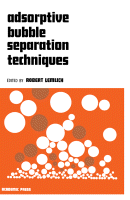Browse content
Table of contents
Actions for selected chapters
- Full text access
- Book chapterNo access
CHAPTER 1 - INTRODUCTION
Robert Lemlich
Pages 1-5 - Book chapterNo access
CHAPTER 2 - MORPHOLOGY, COALESCENCE, AND SIZE DISTRIBUTION OF FOAM BUBBLES
Albert J. de Vries
Pages 7-31 - Book chapterNo access
CHAPTER 3 - PRINCIPLES OF FOAM FRACTIONATION AND DRAINAGE
Robert Lemlich
Pages 33-51 - Book chapterNo access
CHAPTER 4 - ION FLOTATION
T.A. Pinfold
Pages 53-73 - Book chapterNo access
CHAPTER 5 - PRECIPITATE FLOTATION
T.A. Pinfold
Pages 75-90 - Book chapterNo access
CHAPTER 6 - PRINCIPLES OF MINERAL FLOTATION
D.W. Fuerstenau and T.W. Healy
Pages 91-131 - Book chapterNo access
CHAPTER 7 - BUBBLE FRACTIONATION
Robert Lemlich
Pages 133-143 - Book chapterNo access
CHAPTER 8 - SOLVENT SUBLATION
Barry L. Karger
Pages 145-156 - Book chapterNo access
CHAPTER 9 - FOAM SEPARATION OF ENZYMES AND OTHER PROTEINS
Stanley E. Charm
Pages 157-174 - Book chapterNo access
CHAPTER 10 - SURFACTANTS, ORTHOPHOSPHATE, AND PHENOL
Robert B. Grieves
Pages 175-181 - Book chapterNo access
CHAPTER 11 - ION, COLLOID, AND PRECIPITATE FLOTATION OF INORGANIC ANIONS
Robert B. Grieves and Dibakar Bhattacharyya
Pages 183-189 - Book chapterNo access
CHAPTER 12 - FLOTATION OF PARTICULATES: FERRIC OXIDE, BACTERIA, ACTIVE CARBON, AND CLAYS
Robert B. Grieves
Pages 191-197 - Book chapterNo access
CHAPTER 13 - REMOVAL AND USE OF HYDROLYZABLE METALS IN FOAM SEPARATIONS
Alan J. Rubin
Pages 199-217 - Book chapterNo access
CHAPTER 14 - APPLICATION OF ADSORPTIVE BUBBLE SEPARATION TECHNIQUES TO WASTEWATER TREATMENT
David Jenkins, Jan Scherfig and David W. Eckhoff
Pages 219-242 - Book chapterNo access
CHAPTER 15 - SEPARATION OF SURFACTANTS AND METALLIC IONS BY FOAMING: STUDIES IN FRANCE
J. Arod
Pages 243-248 - Book chapterNo access
CHAPTER 16 - SEPARATION OF SURFACTANTS AND METALLIC IONS BY FOAMING: STUDIES IN ISRAEL
Eliezer Rubin
Pages 249-264 - Book chapterNo access
CHAPTER 17 - SEPARATION OF METALLIC IONS BY FOAMING: STUDIES IN ITALY
C. Jacobelli-Turi, F. Maracci, ... M. Palmera
Pages 265-272 - Book chapterNo access
CHAPTER 18 - SEPARATIONS OF PARTICLES, MOLECULES, AND IONS BY FOAMING: STUDIES IN JAPAN
T. Sasaki
Pages 273-278 - Book chapterNo access
CHAPTER 19 - SEPARATION OF SURFACTANTS AND METALLIC IONS BY FOAMING: STUDIES AT RADIATION APPLICATIONS, INC., AND OAK RIDGE NATIONAL LABORATORY, U.S.A.
W. Davis and P.A. Haas
Pages 279-297 - Book chapterNo access
CHAPTER 20 - SEPARATION OF SURFACTANTS AND IONS FROM SOLUTIONS BY FOAMING: STUDIES IN THE U.S.S.R.
V.V. Pushkarev
Pages 299-313 - Book chapterNo access
AUTHOR INDEX
Pages 315-322 - Book chapterNo access
SUBJECT INDEX
Pages 323-331
About the book
Description
Adsorptive Bubble Separation Techniques focuses on the mechanisms of the various adsorptive bubble separation methods. This book examines the various adsorptive bubble separation techniques, including ion flotation, foam fractionation, precipitate flotation, mineral flotation, bubble fractionation, and solvent sublation. Organized into 20 chapters, this book starts with an overview of the certain important properties of foam. This text then examines the results of several separations, as well as the results of additional studies into the mechanisms of the different techniques. Other chapters explain the studies of foam separation in the case of synthetic solutions, which provide a good knowledge of the extraction mechanisms of the radioactive cations, cesium, cerium, and strontium. This book discusses as well the experimental and theoretical work on foam separation done in Israel. The final chapter deals with the separation of surfactants and metallic ions at various places around the world. This book is a valuable resource for materials scientists, engineers, and chemists.
Adsorptive Bubble Separation Techniques focuses on the mechanisms of the various adsorptive bubble separation methods. This book examines the various adsorptive bubble separation techniques, including ion flotation, foam fractionation, precipitate flotation, mineral flotation, bubble fractionation, and solvent sublation. Organized into 20 chapters, this book starts with an overview of the certain important properties of foam. This text then examines the results of several separations, as well as the results of additional studies into the mechanisms of the different techniques. Other chapters explain the studies of foam separation in the case of synthetic solutions, which provide a good knowledge of the extraction mechanisms of the radioactive cations, cesium, cerium, and strontium. This book discusses as well the experimental and theoretical work on foam separation done in Israel. The final chapter deals with the separation of surfactants and metallic ions at various places around the world. This book is a valuable resource for materials scientists, engineers, and chemists.
Details
ISBN
978-0-12-443350-2
Language
English
Published
1972
Copyright
Copyright © 1972 Elsevier Inc. All rights reserved.
Imprint
Academic Press
